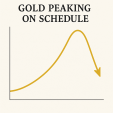Gold Awakes from its 25 Year Slumber
There is presently much debate over whether the gold price has further upside. Gold is at an all time high in nominal terms and one could not be blamed for being cautious when considering its investment viability. Many still remember the speculative high of US$850 an ounce back in 1980 and can recall loosing money, or at least knowing of someone that lost money, at the time. With gold now close to US$1,000 an ounce, some of those memories have been rekindled, creating a sense of apprehension. In investment markets this phenomena is called “The Wall of Worry”. Every bull market goes through it to varying degrees as the investment public deliberates over whether to embrace the legitimacy of the move.
The following charts are designed to assist you, the investor, in this decision making process. Rather than looking at a 25 year time frame, like many analysts conveniently do when analyzing equity market performance versus gold, we will look at the last 50 years. We will look at relevant factors such as:
- Money Supply Growth (M3 3 year Moving Average)
- CPI (Headline Inflation)
- Interest Rates (10 Year Bank Bills)
- The All Ordinaries Index
- The Australian dollar Gold price
To understand gold price performance, you need to grasp the concept of monetary inflation cycles which are generally 10-20 years in duration. Higher monetary inflation (M3 growth) generates higher CPI. With higher CPI comes rising interest rates. Gold performs strongly in this environment as people question the purchasing power of the dollar and become nervous about the market uncertainty surrounding these periods. Higher interest rates generally result in poor performances in the sectors which benefited significantly from extended periods of easy credit. These sectors are namely property and shares.
The following two charts demonstrate the inter-relationship of the above factors for the period of 1959 - 2008. The first chart studies the relationship between factors 1-3. The second looks at the gold price in Australian dollars and the performance of the All Ordinaries index over the same period. For the purpose of this article, I will break up the 50 year period into 3 key 15 year blocks and finish the discussion with a look at the present period and what we can potentially expect.
The Monetary Inflation Cycle: 1959 - 2008

Gold versus the All Ordinaries Index: 1959 - 2008

1960 - 1975
During periods of relatively low monetary inflation (less than 10% - blue line) you generally see tame levels of CPI (less than 4% - red line) and consequently low market rates of interest (less than 7% - green line). As the prolonged effects of an easy monetary policy start to take effect, we see the money supply growth rise as the appetite for credit becomes infectious. This puts upward pressure on CPI which in turn causes higher interest rates. If we look back to the 1960’s and into the early 1970’s, we can clearly see this relationship at work (First Chart). Whilst money supply growth crept higher, it remained below the key 10% level. CPI was lower than 4% and interest rates consequently remained below 7%. The All Ordinaries Index rallied strongly buoyed by easy monetary conditions. The index rallied 125%, from 180 in 1959, to a peak in 1968 of 404. The mid 1970’s saw the money supply growth breach the 10% pa level and with it came a spike in CPI which shot to 17% by 1975. Interest rates predictably climbed to 9.5% in response to the inflationary pressures. The All Ordinaries Index consequently fell 38% to 251 by 1975. Gold during this period rose from AUD$30 an ounce to AUD$120 an ounce, an increase of 300%. A look at the top section of the second chart clearly demonstrates gold’s superior performance.
1975 - 1990
Money Supply growth averages remained stubbornly above 10% throughout the 1970’s and 80’s as recessionary conditions prompted central bank stimulus. Market rates continued to rise on inflationary concerns. The 10 year bank bill rate peaked at about 16.5% by 1982 as the CPI declined to be less than 11%. Inflationary expectations, while stubbornly high, were gradually easing. The gold price continued to outperform the All Ordinaries Index all the way up until the 1980 peak. At AUD$530 an ounce, this represented a further 340% increase since 1975. The All Ordinaries Index rallied 140% to 611. From 1982 to 1990, market rates trended lower as CPI continued to trend down despite the occasional stubborn spike. By 1990, CPI had fallen to 7.5% and the 10 year bank bill rate fell to 13.4%. Money supply growth remained persistently high in response to stock market instability initiated by the 1987 crash and the looming 1990 recession. By 1982, the All Ordinaries Index was clearly starting to outperform the gold price once more. With the continuing trend of lower market rates and lower CPI, the All Ordinaries index rallied to 1,508 by 1990 despite the 1987 crash. This represented an increase of 150% from 1980 while gold managed an unimpressive 8% fall to AUD$485 an ounce.
1990 - 2005
The trend of lower market interest rates and CPI continued throughout the 1990’s and early 2000’s with historically low interest rates achieved by 2003 of just 5% (not seen since the late 60’s). Money Supply growth was significantly below 10% for much of this period and CPI consequently remained below 4%. The All Ordinaries Index surged in this investment favorable environment and by 2005 the index was close to 4,200, an increase of 180% since 1990. The gold price gained just 18% to finish at AUD$570 an ounce. By 2004, money supply growth averages were exceeding 10% once again and by 2005 the 3 year moving average had risen to 10.5%. Despite this, CPI remained stubbornly low at just 2.5%. The 10 year bank bill rate reflected the low CPI and by 2005 remained close to 5%.
2005 – 2008 and Beyond
Since 2005, money supply growth has averaged close to 17% as the RBA has recently injected significant liquidity into the banking system to alleviate the adverse effects of international credit constraints. If you look at the two previous times average money supply growth has spiked to 15% plus, you can see it has corresponded with poor market conditions, namely the mid 1970’s and the late 1980’s (circled in black on the second chart). Underlying CPI remains low at just 3% begging the important question as to whether CPI, in its present format, is effectively gauging inflation (the computation methodology has changed significantly since the 1960’s and 70’s). 10 year bank bill rates have risen marginally to 6.5%. The All Ordinaries Index has fallen 16% to 5,750 from its peak of 6,870 in November 2007. This still represents a gain of 37% since 2005. The gold price in this time has risen to AUD$1,015 an ounce or 78%. Gold has clearly outperformed the All Ordinaries Index by over 100% since 2005. If we look at the top section of the above Gold versus All Ordinaries chart we can see a definitive breakout from the downward trend line that has been in place since 1982.
Inflationary cycles cannot be promptly managed by interest rate adjustments as Keynesian economists would have you believe. Will the present interest rate hikes be successful in curbing inflation? If you have faith in the present computation of CPI you may be forgiven for being optimistic that the RBA will be successful in its “inflation fighting” crusade. On this basis, the recent spike in the gold price will indeed turn out to be an aberration. Alternatively, if you look at the CPI with skepticism (as I do) you may conclude that the present cycle has many years left to play out. If this proves to be the case, the recent rise in gold signals just the beginning of things to come. The top section of the second chart clearly demonstrates that the price of gold is far from expensive in terms of the All Ordinaries Index. The recent change in trend also indicates that gold is expected to outperform over the coming months and years as the markets become increasingly uncertain once again. For anyone interested I write a free newsletter on the precious metals market which you can sign up for at The Global Speculator website below. Past issues of the newsletter may also be accessed.

















